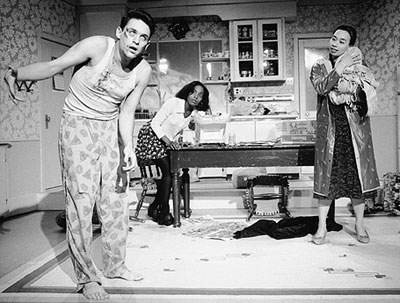
Fall
2001
![]()
Behavioral economist Sendhil Mullainathan adds psychological quirks and foibles to rational economic models
Spotlight on the Center for International Studies
World theater takes center stage at the MIT Theater Arts Program
Kudos to exemplary SHASS staff
The Shakespeare Project leads the humanities into the digital universe
![]()
![]()
Soundings is published by the Dean's Office of the
School of Humanities, Arts, and Social Sciences at MIT
Comments and questions to shass-www@mit.edu
Beyond the dramatic norm

A bloody beginning gets the action rolling in Escape from Happiness, George Walker's black comedy presented in 1966 by the MIT Dramashop and directed by Janet Sonenberg.
Photo: Kevin Simmons.
Beyond problem sets, beyond reaction kinetics, beyond bio-polymers is the MIT Theater Arts Program, where no consensus exists on a single theatrical norm and no effort is made to come up with one. Psychological theater, political theater, musical theater, collective creation, and experimental mixed media grafted onto the presentation stage are all equally at home in the program. "Most university theater departments accept Broadway and its pre-professional aesthetic as the norm for their students," explains Associate Professor Janet Sonenberg, director of the MIT Theater Arts Program. Not MIT. "When you have so many faculty teaching so many differing aesthetics, you can't agree on the theatrical norm," she says, adding that "we're practicing what other departments hope to do in the future."
The 'what' Sonenberg is referring to is world theater, which goes well beyond Brecht and Broadway to encompass contemporary and traditional theater practices from around the world, whether Guillermo Gomez Pena's improvisational theater piece, Ethnographic Museum of Irrelevant Races, Thomas DeFrantz' tap composition with marionettes, Monk's Mood, or Michael Ouellette's revisiting of Sheridan's School for Scandal—all of which have captured the spotlight at MIT in recent years. "Most universities willingly embrace the concept of world theater, but we actually do it," notes Sonenberg. "Our curriculum, our philosophy, our hires, and our productions are based on it and it's unique."
With 11 full- and part-time faculty, an active Visiting Artist program, and members of the Theater Offensive and Shakespeare and Company also teaching classes, the worldly result on the 400 students enrolled in theater classes may appear to be "vast confusion. I may say, 'do it this way.' Another faculty member may have said 'do it that way.' Students have to make up their own minds," says Sonenberg, noting that "students come to recognize that a certain theatrical moment could be completely rethought from another perspective. They don't have to be constrained by what is Chekhovian and realistic. They can co-opt an experimental technique and use it to illuminate that moment in a fresh way, as long as the narrative is compelling and clear." The operative principle is to keep theater a living art, says Sonenberg, "to blow apart people's preconceptions of what this art is, to have people always on the edge of what's possible."
That realm of possibility consists of "Roots of African-American Performance Tradition," "Identity Politics in Performance," "The Actor and the Text," "Script Analysis," "Musical Theater Workshop," or a host of other Theater Arts courses focusing on theory, acting, directing, playwriting, technical theater, or design. Students run the gamut from one-class enrollees to double majors.
How does the stereotypical MIT engineering student fare in this free-for-all quest? "They come vastly innocent of theater," notes Sonenberg. "Initially, they take longer to teach than at other institutions, but once they get it, they ask brilliant, original questions. They can be shockingly creative. And soon they are making truly imaginative work." Sonenberg's pedagogical approach is to "raise the bar rather than lower it. I aim for the most difficult and demanding interpersonal physical work I can find that says, 'This is my kind of theater. Can you do it?' MIT students are up to—and love—the challenge, the bigger the better."
![]()
Copyright © 2001 Massachusetts Institute of Technology